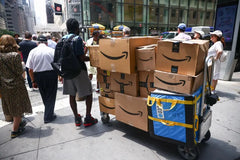
Amazon Prime Day 2023: A Four-Day Shopping Extravaganza That Redefined Consumer Behavior
Table of Contents
- Key Highlights:
- Introduction
- The Start of Something New: Understanding the Initial Decline in Sales
- A Shift in Consumer Dynamics: The Resurgence of Sales
- Discount Strategies: More Deals, Smaller Discounts
- The Role of Engagement in Consumer Behavior
- Amazon's Response to Consumer Trends
- The Future of Prime Day: A New Normal?
- FAQ
Key Highlights:
- Amazon's expansion of Prime Day from two days to four resulted in a 35% decline in sales during the first two days compared to last year, but a significant rebound on the third day with a 165% increase.
- Discount offerings were more numerous, with 25.3% of products discounted, yet average discounts decreased from 24.4% last year to 21.6%.
- Consumer behavior shifted towards cautious spending, with higher engagement but lower conversion rates, as shoppers waited for better deals.
Introduction
The landscape of e-commerce continues to evolve, and Amazon's Prime Day serves as a telling barometer of consumer sentiment and shopping behavior. This year, the retail giant extended its Prime Day festivities from the traditional two days to a full four days, a bold move aimed at maximizing engagement and sales. However, initial data revealed a significant drop in sales during the first two days, prompting questions about the effectiveness of this extended format. As the event unfolded, it became clear that while the early days saw a decline in immediate purchasing, the latter part of the event witnessed a remarkable resurgence in consumer spending, indicating a complex interplay of anticipation and strategy among shoppers.
The Start of Something New: Understanding the Initial Decline in Sales
The first two days of Prime Day 2023 painted a sobering picture for Amazon, with sales plummeting 35% compared to the previous year. Data from Momentum Commerce, a consultancy focusing on e-commerce, highlighted that this decline was observed across key brands generating over $7 billion in sales on Amazon. Notably, consumers appeared to be waiting for better deals, showcasing a shift in shopping behavior.
The drop in sales during the early days can be attributed to heightened consumer expectations and strategic shopping behavior. With the promise of additional discounts on the horizon, many shoppers opted to delay their purchases. This phenomenon reflects a broader trend in which consumers are increasingly inclined to research and wait for optimal pricing rather than making impulsive decisions.
Mike Feldman, Senior Vice President of Commerce at Flywheel, summarized this behavior succinctly: “Click-through rates are up—indicating high engagement—but conversion rates in the first half of the event are softer as shoppers wait for what they perceive to be the best deals.” This suggests that while consumer interest remains robust, the urgency that typically drives immediate purchases has transformed into a more measured approach.
A Shift in Consumer Dynamics: The Resurgence of Sales
Contrary to the initial decline, the third day of Prime Day 2023 experienced an astounding 165% increase in sales year-over-year. This surge can be interpreted as consumers responding to both the urgency of impending deadlines and the realization of better deals as the event progressed. The extended format allowed shoppers to engage in a "marathon" of sorts, where they could browse, compare, and reflect on their purchases over multiple days.
The increased number of products with discounts—25.3% of items sold during the first three days compared to 18.3% last year—played a pivotal role in reigniting consumer interest. However, the average discount dropped from 24.4% to 21.6%, indicating a strategic shift by brands to offer more deals, albeit at lesser savings.
Kashif Zafar, CEO of Xnurta, elaborates on this change in consumer behavior: “We’re seeing higher carting rates without immediate checkout, especially in mid-ticket categories like kitchenware and household goods.” This behavior suggests that shoppers are becoming more deliberate in their purchasing decisions, potentially leading to longer shopping cycles and a reevaluation of how brands engage with consumers.
Discount Strategies: More Deals, Smaller Discounts
The data from Momentum Commerce revealed a nuanced picture of discount strategies employed during Prime Day 2023. While the total number of discounted products increased, the average discount percentages witnessed a decline. This was a shift from previous years when steeper discounts were a hallmark of the event.
In examining price trends, the average discount on the first day was 22.7%, which increased slightly to 26.7% on the third day. This pattern suggests that brands were strategically adjusting their discount offerings, possibly to create a crescendo of savings that would incentivize shoppers to act as the event unfolded.
The implications of this strategy are twofold. On one hand, consumers are presented with numerous opportunities to save, potentially increasing traffic and engagement. On the other hand, the lower average discounts may lead to consumer skepticism about the value of the deals, as shoppers weigh their options more carefully.
The Role of Engagement in Consumer Behavior
The changes in consumer behavior during Prime Day 2023 highlight the critical role of engagement in the shopping experience. As shoppers become more discerning in their purchasing habits, businesses must adapt to a new reality where engagement translates to higher click-through rates but not necessarily immediate conversions.
The rise in click-through rates indicates that consumers are actively browsing and showing interest in products. However, the challenge lies in converting this engagement into sales. Brands need to be agile in their marketing strategies, responding to real-time data and consumer sentiment to optimize their approaches.
The phenomenon of "cart abandonment" has become increasingly prevalent, with consumers adding products to their carts but delaying the final purchase. This behavior reflects a calculated approach where shoppers seek to weigh their options before making a commitment, emphasizing the need for brands to foster a sense of urgency and nudge consumers towards completing their purchases.
Amazon's Response to Consumer Trends
Despite the mixed results during the early days of Prime Day 2023, Amazon's response has been largely positive. An Amazon spokesperson commented, “The response from customers has been very positive, and we look forward to the last day of this year’s Prime Day event.” This optimism is indicative of the company's confidence in its ability to adapt to changing consumer behaviors and preferences.
Amazon's approach to Prime Day has evolved over the years, and the decision to extend the event reflects an understanding of the contemporary shopping landscape. As consumers become more informed and strategic in their buying habits, Amazon’s ability to provide a compelling shopping experience will depend on its adaptability and responsiveness to these trends.
The Future of Prime Day: A New Normal?
The results of Prime Day 2023 raise important questions about the future of promotional events in e-commerce. As consumers evolve, so too must the strategies employed by retailers. The shift towards longer promotional periods, like the four-day Prime Day, may become a blueprint for other retailers seeking to capitalize on consumer engagement without succumbing to the pitfalls of immediate sales pressures.
Moreover, the changing dynamics of discounts and consumer behavior signal a need for retailers to rethink their marketing strategies. As the shopping landscape becomes more competitive, brands that can navigate these changes while maintaining a focus on value and customer experience are likely to emerge as winners.
FAQ
What was the main change in Prime Day 2023 compared to previous years?
Prime Day 2023 was expanded from two days to four days, allowing consumers more time to browse and compare products.
Why did sales decline during the first two days of Prime Day 2023?
Sales decreased by 35% during the first two days as consumers waited for potentially better deals later in the event.
How did consumer behavior change during the event?
Consumers exhibited higher engagement with increased click-through rates, but conversion rates were lower as shoppers were more deliberate in their purchasing decisions.
What were the average discounts during Prime Day 2023?
The average discount was 21.6%, a decrease from 24.4% in the previous year, although the number of discounted products increased.
What implications does the changing consumer behavior have for retailers?
Retailers will need to adapt their marketing strategies to prioritize engagement and responsiveness to consumer preferences, potentially shifting towards longer promotional periods.
Power your ecommerce with our weekly insights and updates!
Forbliv opdateret om, hvad der sker i handelsverdenen
E-mailadresse
Udvalgt til dig

12 July 2025 / Blog
The Rise of Affiliate Marketing: How Businesses Are Shifting Towards Consumer-Driven Recommendations
Læs Mere



